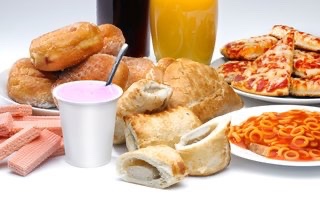All processed foods are bad for you.
It’s a myth I’ve heard since the start of my fitness career. Many people think that almost everything “processed”—those foods typically found in the middle aisles of the grocery store—should be totally avoided.
Although I prefer to shop around the perimeter of the grocery store for fresh fruits and vegetables, meat, milk and eggs, there are a lot of good choices in the center aisles as well. The term “processed foods” encompasses a wide variety of items, including many healthful and nutritious options like nuts, dry beans, frozen veggies, canned salmon, plain oatmeal and wild rice. Let’s process the facts before we deem all “processed foods” as terrible choices for athletes.
We need to better define the word “processed” to ensure we are communicating accurately and consistently with our clients and athletes.
Processed food is defined by the International Food Information Council as any food that has been deliberately changed before being available for human consumption. That change can be “as simple as freezing or drying food to preserve nutrients and freshness, or as complex as formulating a frozen meal with the right balance of nutrients and ingredients.” So even something like a bag of frozen vegetables falls into the category of processed foods, as do many other choices we know to be nutritious.
While many types of processing allow us to eat nutrient-dense foods without having to hunt and gather it ourselves, certain modern methods of processing do little favor for a food’s overall nutrition. Some of today’s food is processed with less fermentation, more bleached flour, added sugar and salt, and less of the good stuff like vitamins, minerals and fiber. Generally speaking, the more processing a food undergoes, the less healthy it usually is. “Minimally processed” foods can be quite nutritious, but “ultra-processed” foods are frequently just the opposite.
According to the NOVA food classification system, ultra-processed foods are “typically not recognizable as versions of foods, although some may imitate the appearance, shape and sensory qualities of foods.” These products are so far removed from actual whole foods and contain so many additives, one cannot distinguish how the food was created. Most of these products didn’t exist 100 years ago, but they now make up the majority of the calories in the average American diet! A 2017 study in the Journal of Population Health Metrics found that more foods labeled as ultra-processed have lower nutrient densities and higher discretionary calories, while unprocessed or minimally processed foods provide greater nutritional value.
Processed foods are not new, but today they tend to make up a much larger part of our diet. However, processed food is not inherently harmful for two distinct reasons.
First, the term “processed food” isn’t monolithic. While frozen mashed sweet potatoes are processed, they offer a higher nutrient density than a cookie.
Second, chronic disease caused by food consumption is nearly always dependent on dose: having Oreos on special occasions is fine; eating Dunkin Donuts every day is not. There’s nothing inherently wrong with processed foods. For many of us, they play an essential role in allowing us to include a variety of nutritious choices in our diets.
“Food processing is necessary. National and global goals for nutrition and health can only can only be accomplish by incorporating attention to food processing into social and economic reforms,” reads an excerpt from the 2014 ASN Scientific Statement.
Good nutrition can certainly be achieved with the help of eating processed foods, and for many people, that may be their only feasible path to better health. The key is not thinking in terms of “processed” versus “unprocessed,” but examining the level of processing present and how that affects the nutrition of the food. In some cases, processing may actually make the food healthier—certain frozen veggies have been found to contain higher concentrations of nutrients than their average fresh counterpart, for example.
When counseling your athletes, it’s important to be aware of the evidence and your athletes’ personal food habits so you can help them achieve a balanced and healthy diet. Teach them how to read labels, ask about nutritional quality, make good choices, and enjoy a treat every now and then.
Story By: Joshua Hockett
